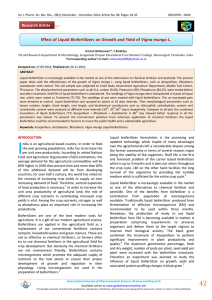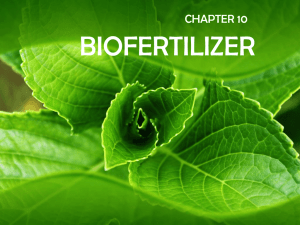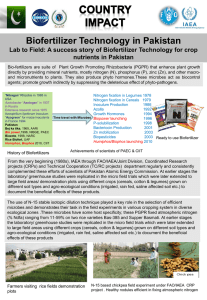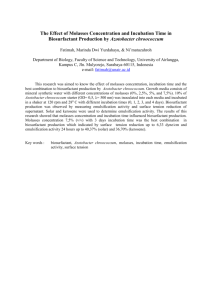Document 13310522
advertisement
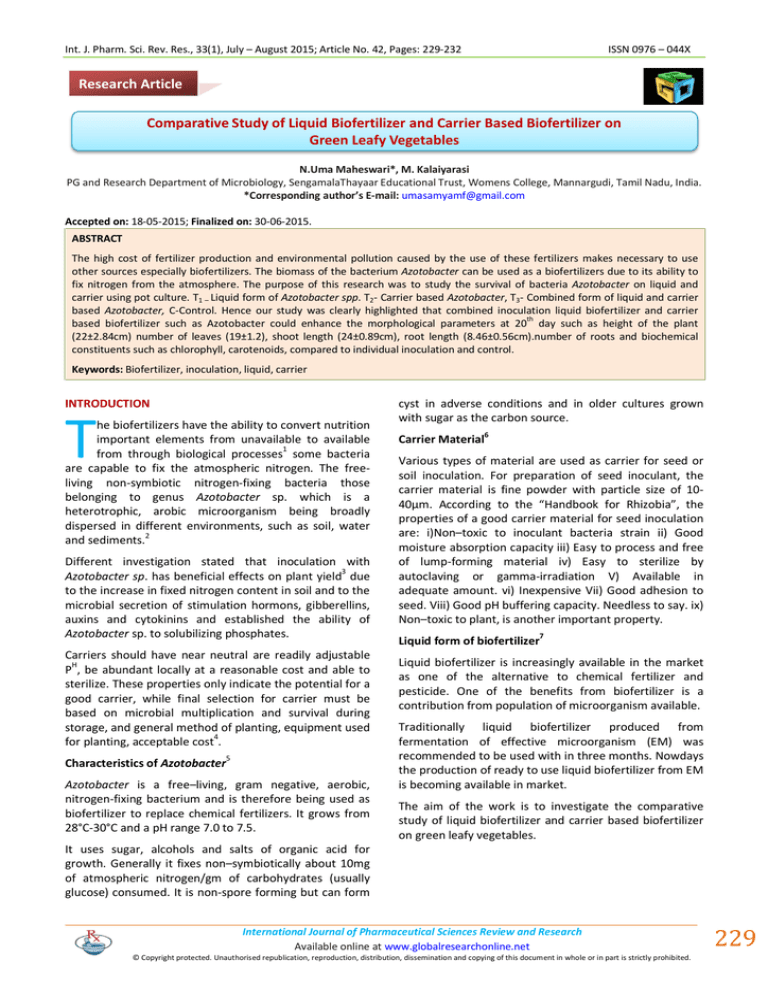
Int. J. Pharm. Sci. Rev. Res., 33(1), July – August 2015; Article No. 42, Pages: 229-232 ISSN 0976 – 044X Research Article Comparative Study of Liquid Biofertilizer and Carrier Based Biofertilizer on Green Leafy Vegetables N.Uma Maheswari*, M. Kalaiyarasi PG and Research Department of Microbiology, SengamalaThayaar Educational Trust, Womens College, Mannargudi, Tamil Nadu, India. *Corresponding author’s E-mail: umasamyamf@gmail.com Accepted on: 18-05-2015; Finalized on: 30-06-2015. ABSTRACT The high cost of fertilizer production and environmental pollution caused by the use of these fertilizers makes necessary to use other sources especially biofertilizers. The biomass of the bacterium Azotobacter can be used as a biofertilizers due to its ability to fix nitrogen from the atmosphere. The purpose of this research was to study the survival of bacteria Azotobacter on liquid and carrier using pot culture. T1 – Liquid form of Azotobacter spp. T2- Carrier based Azotobacter, T3- Combined form of liquid and carrier based Azotobacter, C-Control. Hence our study was clearly highlighted that combined inoculation liquid biofertilizer and carrier th based biofertilizer such as Azotobacter could enhance the morphological parameters at 20 day such as height of the plant (22±2.84cm) number of leaves (19±1.2), shoot length (24±0.89cm), root length (8.46±0.56cm).number of roots and biochemical constituents such as chlorophyll, carotenoids, compared to individual inoculation and control. Keywords: Biofertilizer, inoculation, liquid, carrier INTRODUCTION T he biofertilizers have the ability to convert nutrition important elements from unavailable to available from through biological processes1 some bacteria are capable to fix the atmospheric nitrogen. The freeliving non-symbiotic nitrogen-fixing bacteria those belonging to genus Azotobacter sp. which is a heterotrophic, arobic microorganism being broadly dispersed in different environments, such as soil, water and sediments.2 Different investigation stated that inoculation with Azotobacter sp. has beneficial effects on plant yield3 due to the increase in fixed nitrogen content in soil and to the microbial secretion of stimulation hormons, gibberellins, auxins and cytokinins and established the ability of Azotobacter sp. to solubilizing phosphates. Carriers should have near neutral are readily adjustable PH, be abundant locally at a reasonable cost and able to sterilize. These properties only indicate the potential for a good carrier, while final selection for carrier must be based on microbial multiplication and survival during storage, and general method of planting, equipment used for planting, acceptable cost4. Characteristics of Azotobacter5 Azotobacter is a free–living, gram negative, aerobic, nitrogen-fixing bacterium and is therefore being used as biofertilizer to replace chemical fertilizers. It grows from 28°C-30°C and a pH range 7.0 to 7.5. cyst in adverse conditions and in older cultures grown with sugar as the carbon source. Carrier Material6 Various types of material are used as carrier for seed or soil inoculation. For preparation of seed inoculant, the carrier material is fine powder with particle size of 1040µm. According to the “Handbook for Rhizobia”, the properties of a good carrier material for seed inoculation are: i)Non–toxic to inoculant bacteria strain ii) Good moisture absorption capacity iii) Easy to process and free of lump-forming material iv) Easy to sterilize by autoclaving or gamma-irradiation V) Available in adequate amount. vi) Inexpensive Vii) Good adhesion to seed. Viii) Good pH buffering capacity. Needless to say. ix) Non–toxic to plant, is another important property. Liquid form of biofertilizer7 Liquid biofertilizer is increasingly available in the market as one of the alternative to chemical fertilizer and pesticide. One of the benefits from biofertilizer is a contribution from population of microorganism available. Traditionally liquid biofertilizer produced from fermentation of effective microorganism (EM) was recommended to be used with in three months. Nowdays the production of ready to use liquid biofertilizer from EM is becoming available in market. The aim of the work is to investigate the comparative study of liquid biofertilizer and carrier based biofertilizer on green leafy vegetables. It uses sugar, alcohols and salts of organic acid for growth. Generally it fixes non–symbiotically about 10mg of atmospheric nitrogen/gm of carbohydrates (usually glucose) consumed. It is non-spore forming but can form International Journal of Pharmaceutical Sciences Review and Research Available online at www.globalresearchonline.net © Copyright protected. Unauthorised republication, reproduction, distribution, dissemination and copying of this document in whole or in part is strictly prohibited. 229 © Copyright pro Int. J. Pharm. Sci. Rev. Res., 33(1), July – August 2015; Article No. 42, Pages: 229-232 ISSN 0976 – 044X MATERIALS AND METHODS Analysis of Nutrient Status Soil Sample Collection Nitrogen ,phosphorus, potassium, were also estimated by standard method.11-13 The Soil samples were collected from paddy field at vilakkudi in Thiruvarur district using sterile polythene bag. 8 Isolation Of Azotobacter From Soil Sample Azotobacter was isolated from the soil sample by serial dilution as 1.0g of air dried samples was dissolved in 99ml of distilled water. The soil suspension was further diluted up to 106 level. The diluted soil suspension (0.1ml) was spread on the surface of Jensen agar medium which is a selective medium for isolating Azotobacter. The pH of the medium was adjusted to 7.0 with the help of 1N HCl/1N ◦ NaOH. The plates were incubated at 28 C for 5-7 days and the colonies were observed. Strains of Azotobacter were picked out and purified by repeated streaking on Jensen medium and were preserved as slant culture for further usage. Large mucoid opaque colonies were observed after 5-7 days. Biochemical Constituents Chlorophyll, total chlorophyll, carotenoids were also estimated9,10. Pot Culture Technique A pot culture experiment was conducted in garden soil with the following treatment. Plants were used for this investigation namely green leaf vegetables. The plants were treated with Azotobacter, and respectively by the following method. Seed Treatment The seeds were soaked in Azotobacter, culture for over night and pot culture were carried out Treatment There were 4 treatments resulting from combination of T1 – Liquid form of Azotobacter spp. T2 - Carrier based Azotobacter. T3- Combined form of liquid and carrier based Azotobacter. C-Control There were four replications for each treatment. The pots were maintained in the open shade at the temperature of 27°C-30°C. Morphological Parameter th th th After 7 , 15 , and 20 days of growth, 3 plant for per pot were removed from all sample, and studied for the following morphological parameters they were, Height of the plant (in cm), Number of leaves (per plant), Number of roots (per plant), Root length (in cm), Shoot length (in cm ). RESULTS The effect of biofertilizer treatment on vegetative growth of green leafy vegetables was significantly higher in combined inoculation of liquid and carrier based Azotobacter (T3) than control. A significant variation in plant height and number of leaves due to application of biofertilizer was noticed. Statistically significant increase in plant height, number of leaves, shoot length, root length, number of roots. Isolation and Identification of Bacteria Soil sample was collected from Vilakkudi, ThiruvarurDistrict, Tamil Nadu, South India. Azotobacter sp were isolated from the soil sample by serial dilution technique by streak plate method. In the gram staining technique gram negative and motile bacteria were observed. In was confirmed by different biochemical test, the identified bacterial colonies are Azotobacter. The identified organisms are able to produce separate colonies on different culture media. Pot culture Treatment The soil sample was subjected to Tamilnadu, Government Agriculture Department, mobile test centre, Thiruvarur. The physicochemical parameters such as pH (6.4), nitrogen (0.06 ppm), pottasium (39 ppm) ,Phosphorus (84.25 ppm) were tested for before and after treatment. Height of the Plant Combined inoculation of liquid and carrier based Azotobacter (T3) in 20thday the yield concepts such as height of the plant (23±2.84cm) was noted in (Table-1) followed by other treatments and control (Table-2). In 20th day liquid biofertilizer of Azotobacter (T1) was agreed with above said response in height of plants (22.5±1.80cm) followed by other treatments and control (Table-1). Number of Leaves Combined inoculation of liquid and carrier based th Azotobacter (T3) in 20 day the yield concepts such as height of the plant (20.6±1.2cm) was noted in (Table-4) th followed by other treatments and control (Table-2).In 20 day liquid biofertilizer of Azotobacter (T1) was agreed with above said response in height of plants (20.4±3.39cm) followed by other treatments and control (Table-1). Shoot Length Similar observations were made, combined inoculation of liquid and carrier based Azotobacter (T3) in 20th day was showed better response in shoot length of plants (18.5±0.89cm) followed by other treatments and control th (Table-1). In 20 day carrier based Azotobacter (T2) was International Journal of Pharmaceutical Sciences Review and Research Available online at www.globalresearchonline.net © Copyright protected. Unauthorised republication, reproduction, distribution, dissemination and copying of this document in whole or in part is strictly prohibited. 230 © Copyright pro Int. J. Pharm. Sci. Rev. Res., 33(1), July – August 2015; Article No. 42, Pages: 229-232 exhibited better response in shoot length plants (15.6±6.74cm) followed by other treatments and control. Root Length The comparative account of overall treatments combined inoculation of liquid and carrier based Azotobacter (T1) in 20th day was showed better response in root length of plants (8.46±0.56cm) followed by other treatments and control (Table-1). In 20th day liquid biofertilizer alone Azotobacter(T1) was exhibited better response in root length plants (7.55±0.96cm) followed by other treatments and control (Table -1). Estimation of Chlorophyll th In 20 day, among the overall treatments combined inoculation of liquid and carrier based Azotobacter (T3) was showed higher activity in Chlorophyll-a (0.643± 0.56 mg/g) ,Chlorophyll-b (0.0598± 0.087 mg/g) and total Chlorophyll content (0.0678±0.087 mg/g) of plants followed by other treatments and control (Table-2). T1, T2, alone in 20th day was exhibited better response in Chlorophyll-a, Chlorophyll–b, and total Chlorophyll content followed by control. ISSN 0976 – 044X Carotenoids content in Liquid Biofertilizer Treatment In 20th day, among the overall treatments combined inoculation of liquid and carrier based Azotobacter (T3) was showed higher activity in Cartenoids of plants (0.598± o.67 mg/g) of plants followed by other treatments and control (Table-2). T1, T2, alone in 20th day was exhibited better response in followed by control. Hence our study was clearly highlighted that combined inoculation liquid biofertilizer and carrier based biofertilizer such as Azotobacter could enhance the morphological parameters such as height of the plant, number of leaves, shoot length, root length, number of roots and biochemical constituents such as chlorophyll, carotenoids, compared to individual inoculation and control. This could be the collective effect of liquid biofertilizer and also reduce the use of chemical fertilizer. Inoculation with plants promoting rhizobacteria (PGPR) may enhance crop productivity either by making other nutrients available or protecting plants from pathogenic microorganisms. Table 1: Impact of liquid biofertilizers on morphological parameters in Amaranthusretroflexus (20thday) Treatment Height of the plant (cm) Number of leaves (cm) Shoot length (cm) Root length (cm) T1 17 ± 1.80 cm 16 ± 3.39 cm 17.3 ± 1.52cm 7.55 ± 0.96cm T2 15 ± 2.57 cm 15±3.2 cm 15.6 ± 6.74 cm 7.46 ± 0.89 cm T3 22 ± 2.84 cm 19 ± 1.2 cm 24 ± 0.89 cm 8.46 ± 0.56 cm C 15.6 ± 6.74 cm 11.7 ± 2. 02 cm 16 ± 0.71 cm 6.15 ± 0.25 cm Values are triplicates represented as mean + standard deviation Table 2: Biochemical constituents in Amaranthusretroflexus (20th day) Carotenoids Treatment Chlorophyll a (mg/g) Chlorophyll b (mg/g) Total chlorophyll (mg/g) T-1 0.453±0.43 0.0389±0.86 0.0452±0.12 0.423±0.56 T-2 0.410±0.028 0.355±0.43 0.480±0.080 0.389±0.86 T-3 0.643±0.56 0.0598±0.067 0.678±0.087 0.484±0.049 C 0.0321±0.09 0.0311±0.076 0.412±0.56 0.311±0.076 (mg/g) Values are triplicates represented as mean + standard deviation CONCLUSION REFERENCES Overall, our study was showed the isolation and identification of Azotobacter that has the potential to be used as a biofertilizer. These attributes of the isolate will be of great advantage in agriculture field next trial play a vital role in plant growth promotion, disease suppression and sub sequent enhancement of yield. Liquid biofertilizer have the capacity to replace the traditional chemical fertilizer and carrier based biofertilizer play a major role in restoring soil health. But a lot of measures in terms of technology, Government support, and constructive awareness by well trained technicians one needed. 1. Vessey JK, Plant growth promoting rhizobacteria as biofertilizer. Plant soil, 255, 2003, 571-586. 2. Palleroni, NJ, Gram negative aerobic rods and cocci. In: Krieg, N.R. (Ed.), Bergey's Manual of Systematic Bacteriology. Williams and Wilkins, Baltimore, 1984, 140199. 3. Idris M., Effects of integrated use of mineral, organic N and azotobacter on the yield, yield components and N-nutrition of wheat (Triticumaestivum L.). Pakistan Journal of Biological Sciences, 6, 2003, 539-554. 4. Van Veen JA, Van Overbeek LS, vanElsas JD, Fate and activity of microorganisms introduced into soil. Microbiology Reviews and molecular Biology, 61, 1997, 121-135. International Journal of Pharmaceutical Sciences Review and Research Available online at www.globalresearchonline.net © Copyright protected. Unauthorised republication, reproduction, distribution, dissemination and copying of this document in whole or in part is strictly prohibited. 231 © Copyright pro Int. J. Pharm. Sci. Rev. Res., 33(1), July – August 2015; Article No. 42, Pages: 229-232 ISSN 0976 – 044X 5. Aneja, Characterization of bacterial community in rhizophere soil of grain Legumes. Microbial. Ecol. 49, 2005, 407-415. 10. Davies BH, Carotenoids. In Goodwin TW (ed), Chemistry and biochemistry of plant pigments. Academic press, London, 2(2), 1976, 38-165. 6. Subba Rao NS, An Appraisal of biofertilizers in India. Biotechnology of Biofertilizers. Maximising the Use of Biological Nitrogen Fixation in Agriculture (Ed S Kannaiyan) Narosa Pub. House, New Delhi, 2001, 375. 11. Das IA, Viability and estimation of shelf life of bacterial population. Journal of Applied Microbiology, 10, 1962, 442472. 7. Hamid Abbasdokht, The study of Azotobacter chroococum inoculation on yield and postharvest quality of wheat (Triticumaestivum).International meeting on soil fertility land management and agroclimatology. 2008, 885-889. 8. Brown ME, plant growth substances produced by microorganisms in soil and rhizosphere J.Appl.bacterial; 35, 1972, 443-451. 9. Arnon DI, Copper enzymes in isolated chloroplasts, polyphenol oxidase in Beta vulgaris. Plant Physiol., 24, 1949, 1-15. 12. Jaczolt discovery of A.paspali Annals of microbiology, DoklAkadNauk effect of Azotobacter on the oxidation reduction potential of plant tissue. Microbiology, 1957, 186-188. 13. Gupta, p, Studies on shelf – life of fly – ash based Azotobacter chroococcum formulation and its bio – efficacy in wheat. Research Journal of Agriculture and Biological Sciences, 6(3), 2010, 280–282. Source of Support: Nil, Conflict of Interest: None. International Journal of Pharmaceutical Sciences Review and Research Available online at www.globalresearchonline.net © Copyright protected. Unauthorised republication, reproduction, distribution, dissemination and copying of this document in whole or in part is strictly prohibited. 232 © Copyright pro
